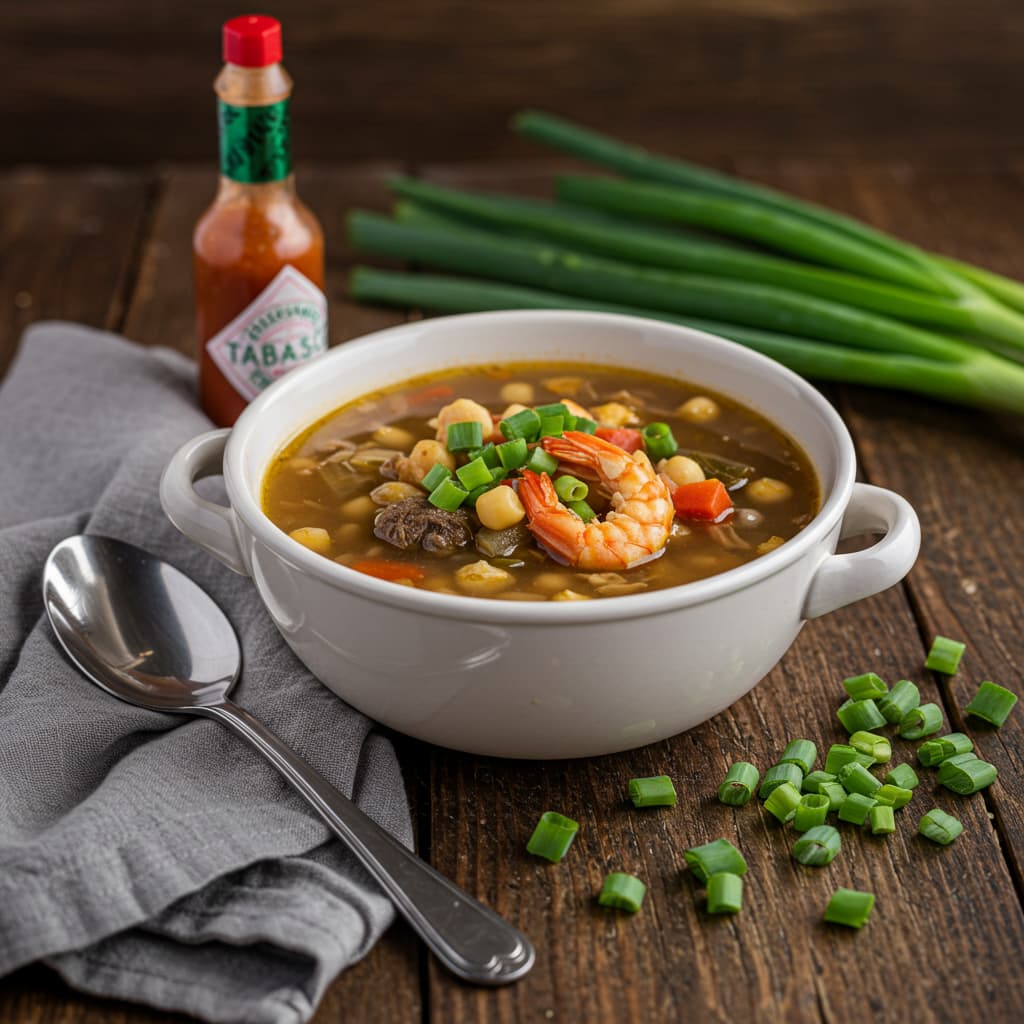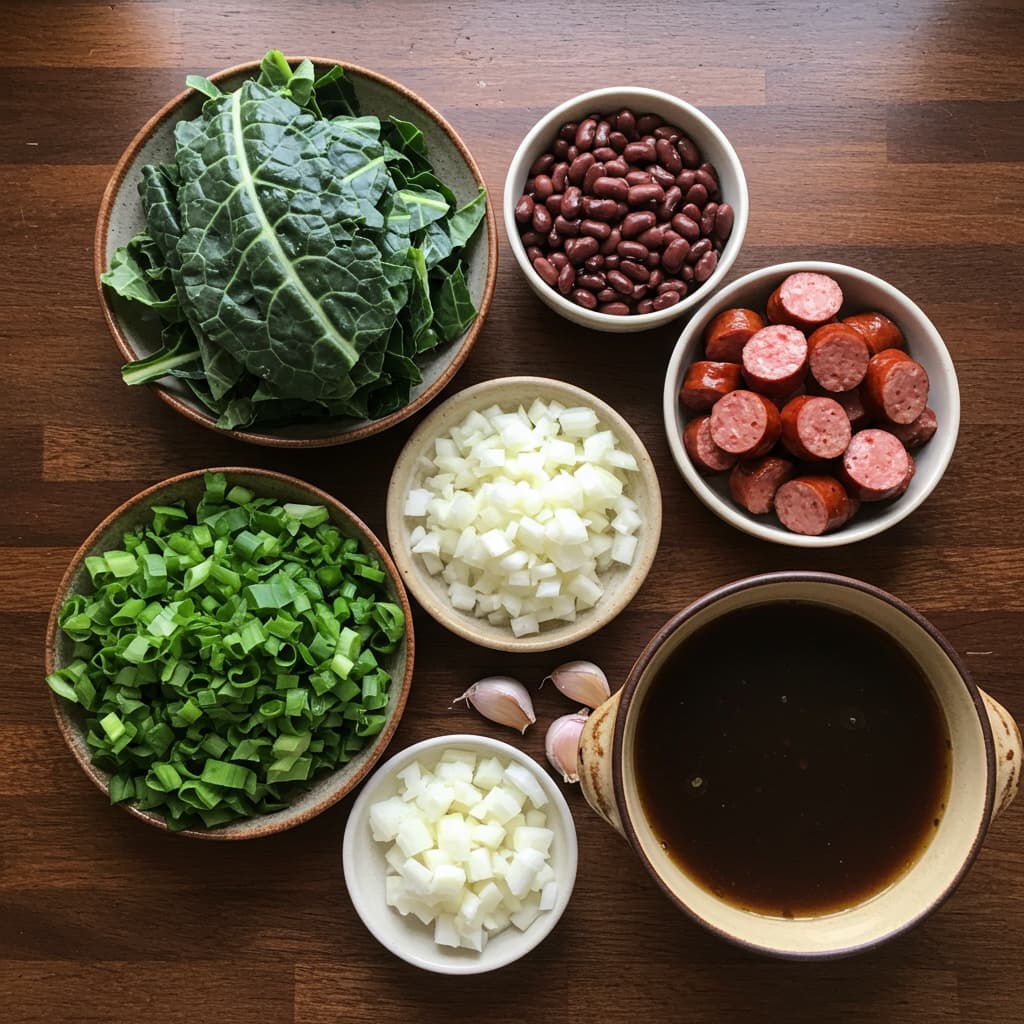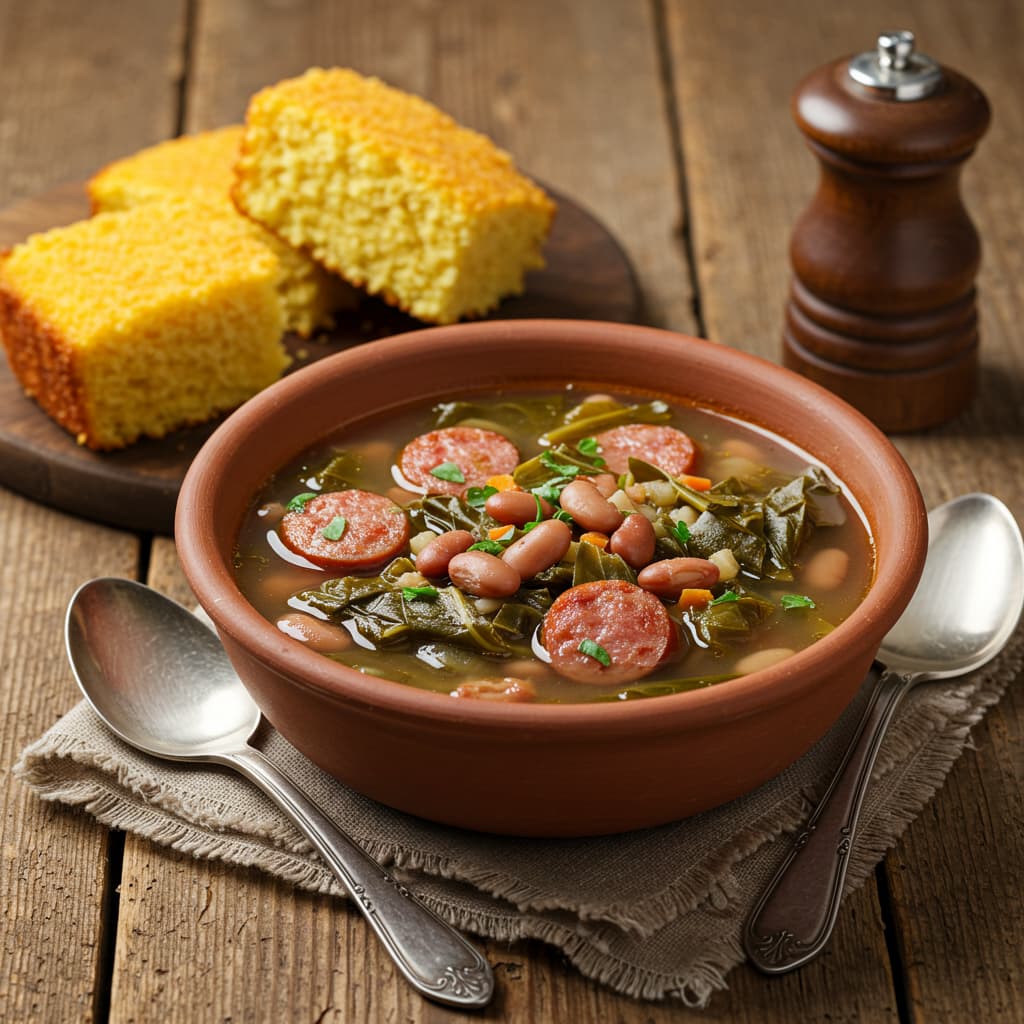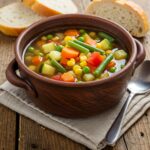Introduction
Tired of bland, watery soups that leave you unsatisfied and reaching for snacks an hour later? This authentic Swamp Soup Recipe delivers a rich, hearty bowl packed with tender meat, robust vegetables, and bold Cajun flavors that will warm you from the inside out and keep you satisfied for hours.
As a Southern cook who’s been perfecting Cajun and Creole recipes for over 15 years, I’ve learned that the secret to exceptional swamp soup lies in building layers of flavor achieved through skillful browning and the foundational “Holy Trinity” of Cajun cuisine. This rustic, soul-warming soup transforms simple ingredients into an extraordinary meal that tastes like it’s been simmering in a Louisiana bayou kitchen all day.
In this comprehensive guide, you’ll master the authentic Swamp Soup Recipe through five simple steps – from selecting the perfect combination of meats and understanding the importance of a dark roux to achieving that signature muddy appearance and complex flavor profile. I’ll share traditional techniques, ingredient substitutions, and pro tips that will make this hearty soup your go-to comfort food for cold nights and family gatherings.
Table of Contents

Why This Soup Recipe Works
The Swamp Soup Recipe has become a beloved comfort food staple because it delivers on every level:
- Uses affordable cuts of meat that become incredibly tender through slow simmering
- Takes just 30 minutes of active prep time with hands-off cooking thereafter
- Perfect for feeding large families or meal prepping for the entire week
- The “holy trinity” vegetables provide a perfect flavor foundation every time
- Creates a complete meal in one pot with protein, vegetables, and satisfying broth
- Improves in flavor over time, making leftovers even more delicious than the original
Choosing the Right Proteins
Best Meat Combinations for Swamp Soup Recipe
Traditional Swamp Soup Recipe combines three proteins for maximum flavor: spicy andouille sausage for smokiness, chicken thighs for tender meat that won’t dry out, and shrimp added at the end for sweetness and authentic bayou flavor. This trinity creates the complex taste profile that makes swamp soup so satisfying and distinctive.
Buying Tips for Authentic Results
Look for authentic andouille sausage from Louisiana brands like Jacob’s or Savoie’s – the real deal has a firm texture and pronounced smoky flavor that grocery store “andouille” can’t match. Choose bone-in chicken thighs over breasts for superior flavor and moisture retention. For shrimp, medium-sized (31-40 count) works perfectly and won’t become rubbery during the brief cooking time.
Protein Substitutions and Alternatives
If andouille isn’t available, kielbasa or smoked sausage work as substitutes, though you’ll want to add extra Cajun seasoning for heat. Turkey sausage creates a lighter version while maintaining the smoky element. For pescatarian versions, use smoked fish like catfish or redfish along with extra shrimp. Duck or rabbit can replace chicken for a more authentic Louisiana wild game experience.
Ingredients & Prep
The Holy Trinity Foundation
Every authentic Swamp Soup Recipe starts with the holy trinity – equal parts diced onions, celery, and bell peppers. This aromatic base provides the flavor foundation that distinguishes Cajun cooking from other regional cuisines. Dice vegetables uniformly for even cooking, and don’t skip the celery as it adds crucial depth and subtle bitterness that balances the rich flavors.
Essential Seasoning and Spice Blend
The signature muddy color and complex flavor come from a dark roux combined with Cajun seasoning, bay leaves, and fresh thyme. Your roux should reach a deep chocolate brown color – this takes patience but creates the nutty, complex flavor that defines authentic swamp soup. Premade Cajun seasoning works fine, but making your own with paprika, cayenne, garlic powder, and oregano allows you to control the heat level.
Stock and Liquid Components
Use rich chicken stock as your base rather than water for maximum flavor depth. Many traditional recipes include a splash of dark beer like Abita Amber or a robust stout, which adds complexity without overwhelming the other flavors. A dash of Worcestershire sauce and hot sauce (preferably Louisiana-style like Tabasco or Crystal) provide the final flavor adjustments that bring everything together.

Step-by-Step Cooking Instructions
Step 1: Create the Perfect Roux Base
In a large, heavy-bottomed pot, heat ½ cup of vegetable oil over medium heat. Gradually whisk in ½ cup of all-purpose flour, making sure to stir constantly to prevent any burning. Keep cooking and stirring for 15-20 minutes until your roux transforms into a deep chocolate brown color. This crucial step truly pays off, developing a rich, nutty flavor that forms the very foundation of your soup.
Step 2: Build the Aromatic Vegetable Base
Add the diced holy trinity vegetables (2 cups each of onions, celery, and bell peppers) to your dark roux, stirring immediately to prevent the roux from burning. Continue cooking for 8-10 minutes, or until the vegetables are tender and fragrant. Add minced garlic, bay leaves, and Cajun seasoning, cooking for another 2 minutes until the garlic becomes aromatic.
Step 3: Add Proteins and Liquid
Slice the andouille sausage and add it to the pot along with bite-sized pieces of chicken thighs. Cook for 5 minutes to lightly brown the proteins. Then, gradually whisk in 8 cups of warm chicken stock, stirring constantly to ensure a smooth, lump-free sauce.Bring to a boil, then reduce heat and simmer covered for 45 minutes until chicken is tender.
Step 4: Final Seasoning and Shrimp Addition
Now, taste the soup and adjust the seasoning as needed with salt, pepper, hot sauce, and more Cajun seasoning. Add the raw shrimp during the last 5 minutes of cooking – they’ll turn pink and curl when done. Avoid overcooking the shrimp as they’ll become tough and rubbery.
Step 5: Allow to Rest and Serve for Enhanced Flavor
Remove the soup from the heat and let it rest for 10 minutes before serving. This crucial step allows all the flavors to meld beautifully and helps the soup reach the perfect serving temperature. Remove bay leaves before serving. The soup should have a rich, muddy brown color with visible specks of seasoning – this rustic appearance is exactly what you want.
Pro Tips for Perfect Swamp Soup
Achieving the Signature “Muddy” Appearance
The characteristic swamp-like appearance comes from properly browning your roux to a deep chocolate color and allowing the Cajun seasonings to bloom in the oil. Don’t rush the roux – a pale roux won’t provide the color or flavor depth needed. The soup should look murky and earthy, not clear or bright.
Essential Tool Recommendations
A heavy-bottomed Dutch oven or large soup pot prevents hot spots that can burn your roux. A long-handled wooden spoon is essential for constant stirring without scratching your pot. Keep a wire whisk handy for incorporating the stock smoothly into the roux. A ladle with a spout makes serving easier and neater.
Storage and Reheating Perfection
Swamp Soup Recipe actually improves after a day in the refrigerator as flavors continue to develop. Store in the refrigerator for up to 4 days or freeze for up to 3 months. When reheating, do so gently over medium-low heat, stirring occasionally. You may need to add a splash of stock as the soup thickens upon cooling.
Flavor Variations
Heat Level Adjustments
For mild versions, reduce the Cajun seasoning and use sweet Italian sausage instead of andouille. Medium heat lovers can add diced jalapeños with the holy trinity. For serious heat seekers, incorporate habanero peppers or ghost pepper seasoning, but start with tiny amounts as these pack serious punch.
Dietary Modification Options
Create a lighter version using turkey andouille and removing the roux altogether – thicken instead with a slurry of cornstarch and cold water. For gluten-free needs, substitute rice flour or gluten-free flour blend for the roux. Vegetarian versions work beautifully with mushroom stock, smoked paprika, and hearty vegetables like okra and tomatoes.
Regional and Seasonal Variations
Summer variations can include fresh okra and tomatoes for a more gumbo-like consistency. Fall versions benefit from diced sweet potatoes or butternut squash. Some Louisiana cooks add oysters during the last few minutes for extra richness. Creole variations include diced tomatoes.
Serving Suggestions
Traditional Accompaniments
Serve your Swamp Soup Recipe over steamed white rice to soak up the flavorful broth and make it more filling. Classic sides include cornbread with honey butter, coleslaw for cooling contrast, and pickled okra or hot sauce on the table for those who want extra heat. A simple green salad with vinaigrette cuts through the richness beautifully.
Beverage Pairings
The rich, spicy flavors pair wonderfully with cold beer – try wheat beers, amber ales, or even light lagers that won’t compete with the complex soup flavors. Sweet tea or lemonade provide refreshing non-alcoholic options.
Creative Serving Ideas
Transform leftovers into a hearty breakfast by topping with a poached egg and serving over grits. Use as a sauce over pasta for a Cajun-Italian fusion dish. The soup also makes an excellent base for jambalaya – just reduce the liquid and add rice directly to the pot.

FAQs
Can I make this soup without seafood?
Absolutely! Simply omit the shrimp and use additional chicken or sausage. You might want to add a splash of Old Bay seasoning to maintain some seafood essence, or include some fish sauce for umami depth without actual seafood.
How do I fix a broken or lumpy roux?
If your roux separates or becomes lumpy, remove it from heat immediately and whisk vigorously. Strain the mixture through a fine-mesh sieve if lumps persist. Prevention is key – maintain constant stirring and moderate heat throughout the roux-making process.
Why does my soup taste bland despite following the recipe?
Swamp soup relies heavily on building layers of flavor. Ensure you’re browning the roux properly, using quality Cajun seasoning, and allowing adequate simmering time. Taste and adjust seasoning at the end – you may need more salt, hot sauce, or Cajun seasoning than anticipated.
Can I use a slow cooker for this recipe?
While possible, slow cookers don’t allow for proper roux development, which is crucial for authentic flavor and appearance. If using a slow cooker, make the roux separately on the stovetop first, then transfer everything to the slow cooker for the long simmering process.
Conclusion
Master this authentic Swamp Soup Recipe and you’ll have a soul-warming, crowd-pleasing meal that brings the flavors of Louisiana straight to your kitchen. The combination of perfectly browned roux, aromatic vegetables, and quality proteins creates a soup that’s both rustic and sophisticated – comfort food at its absolute finest.
Join thousands of home cooks who’ve discovered that the best swamp soup comes from patience, quality ingredients, and time-honored techniques passed down through generations of Louisiana cooks. Once you taste this rich, complex soup, you’ll understand why it’s been a bayou favorite for generations.


